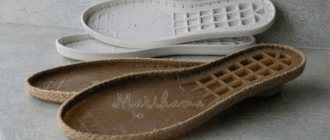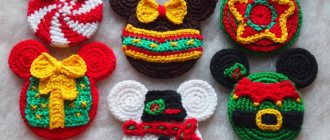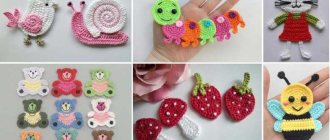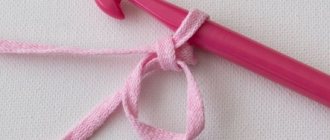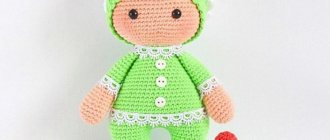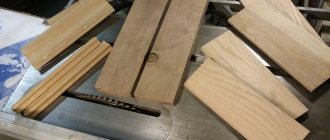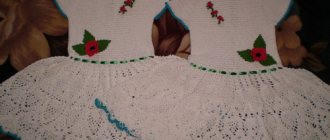In order not to look for scattered items around the house, skilled needlewomen came up with crocheted pockets for small items. Cute organizers of different shapes and sizes occupy their rightful place in the interior and decorate the everyday life of small and large apartment residents.
Universal pocket
To begin with, the needlewomen are presented with the simplest pocket of two parts. The upper and lower parts of the accessory are knitted using the same pattern. The differences are that the large part is made with a regular mesh, and a fillet pattern is added to the upper triangle. It is only important to start the work correctly:
- Using hook No. 2.5, cast on a chain of 10 air loops - 4 bases + 2 + 4 loops.
- Knit a chain loop with 1/2 yarn overs in 10 stitches.
Next, knit strictly according to the instructions!
The pattern reveals in detail the secrets of simple knitting, and the result is sure to exceed your wildest expectations!
Rainbow hook organizer
Oh, how many flowers, how much color and positivity are contained in this work! This hook organizer is created for joy, for smiles and sincere fun. A rainbow is generally a completely inspiring thing; looking at it, you want to create and create, and if it also stores your creative tools, cool projects are guaranteed for you!
How to knit a rainbow hook organizer - job description from Crochetverse.com
Knitted pockets for dad, mom and baby
Using one simple pattern, it’s easy to create slipper pockets for all family members.
It all started as usual! The needlewoman knitted one slipper for dad, but decided that it was very beautiful and should not be worn, but rather hung on the wall for a good mood.
Using the same pattern, but reducing the size, the craftswoman made pocket slippers for the whole family.
The work is very interesting and creative! The remains of any yarn will be used; for density it is better to knit in 2 threads. To adjust the size of the sole, it is enough to reduce the number of air loops in the central chain.
Next, according to a simple pattern, the toe is made and sewn to the sole with a contrasting thread. Using knitted parts and small accessories, personalized faces are decorated, and pendants are sewn on the reverse side.
It turns out fun, funny and practical at the same time. Let everyone decide for themselves what to store in a knitted pocket, and now the hidden item will definitely not be lost!
Panel with pockets on the wall
To create such a wonderful thing, you will need some yarn of different colors, a hook No. 3, eyes for fish, small decorations and a bright flight of imagination.
The work begins with a chain of 99 air loops - 94+3+2 lifts. Next, the cells of the fillet mesh are made, of which there should be 31 pieces along the length of the entire canvas. Next, 70 rows of the main part are knitted in forward and reverse directions.
When the main canvas is ready, the work returns to the first row. From the central chain, a fillet mesh is made up, which will serve as a future capacious pocket.
All that remains is to connect all the interesting things! Using the presented diagrams, create fish and sea creatures, add stars and green algae. It is important to make a neat band around the perimeter, which will add the final finishing touches to the bright panel. At the top of the organizer, a wooden knitting needle is passed through the mesh cells to give shape to the hanging canvas. And for beauty, you definitely need to sew shiny sequins onto the appliques.
Advice! Mesh wall organizers can serve not only as pockets for a variety of items. Hairpins, jewelry, sewing needles and various reminder notes are attached to the mesh.
Hanging pockets for a baby crib
For mothers whose babies are growing up, hanging organizers for cribs make their work much easier. Openwork fabrics with patch pockets combine practicality, functionality and bring delicate beauty to the interior of a children's bedroom.
It’s easy to knit such a convenient little thing! It is advisable to use white or beige cotton threads for the base and multi-colored yarn for bright pockets. The width and length of the organizer depends on the height of the crib.
On the main openwork fabric you can place 4 or 6 pockets, which are knitted according to the presented patterns. To reduce the size of the pocket, just knit it with a smaller crochet hook (for example, replace No. 3 with No. 2 or 1.5).
In the pictures, an empty cell means a column of s/n and 2 air, and a cell with a cross means 3 columns of s/n. Next, according to the openwork pattern, the four sides of the organizer are finished and long pendants are attached, which are fastened with buttons.
Advice! To prevent the pockets from stretching and deforming, it is advisable to sew light fabric on the wrong side. The fillet pattern will look even brighter and more beautiful!
Bathroom decor: pockets for combs and other small items
Crocheting will help you create a wonderful bathroom organizer with pockets for combs and various feminine items.
A short MK with a video tutorial and tips from a skilled needlewoman will show you how to do this.
The video is truly interesting and will make those who have not yet taken the hook try to do so this coming weekend!
Organizer-handbag
Everyone has known for a long time: a thing created with love and with your own hands is liked a million times more than any industrial, ideal, expensive, high-quality one. A knitting bag organizer is just that case: it will bring positivity and joy simply because it was made by you and for you.
How to knit a handbag organizer with your own hands - job description from Marleen Hartog on ravelry
Hanging organizer with pockets for the wall or cabinet
An original little thing for storing small items can be knitted in one evening. A hanging organizer will decorate the wall or hide in a clothes closet to serve the housewife as a convenient device for all small things.
To knit such a thing, you will need 150-200 g of dense yarn and a No. 3 hook. To begin with, you should cast on a chain of 78 loops - 75 base + 3 rises and knit according to openwork pattern No. 1 in the forward and reverse direction, 55 rows in total.
On a note! The last 56 and 57 rows are made with regular double crochet stitches, then they are folded to the wrong side and sewn together. This will create a cavity into which a wooden stick can be inserted for rigidity.
Next, the work returns to the first row, and the first pocket is knitted on the back side of the chain. According to pattern No. 2, 20 rows are made in height, the first pocket is obtained, from row 21 the work moves on to knitting the second pocket. If desired, the needlewoman can make a third pocket 15 rows high.
Finally, piping is performed around the entire perimeter of the product, and the sides of the pockets are attached to the fabric. All that remains is to make a pendant from an air chain and place the organizer in a place convenient for the owner.
Fabric wall organizer with 14 pockets - step by step
This cool organizer is suitable for storing both circular knitting needles and simple knitting needles and hooks. For this work we will need a piece of thick fabric measuring 72.5/47.5 cm. And the same piece of fabric for the lining. The fabric for the lining can be sewn from several pieces.
In addition, an organizer for knitting needles and hooks, a DIY master class, is impossible without pockets. For pockets we take thick fabric (old jeans will do) and thick polyethylene.
Before making an organizer for scissors, knitting needles and hooks, smooth all pieces of fabric well with an iron. The product is put on by the loops on a thick stick; you can use a regular hanger instead of a stick. The pattern is given without seam allowance. It would be simply wonderful to strengthen the main part with a material such as dublerin or non-woven fabric.
To work you will need:
- A piece of thick fabric 72.5/47.5 cm for the base and the same piece of thin fabric for the lining.
- 2 pieces of thick fabric, 30/62.5 cm each, for the lower pockets.
- 2 pieces of polyethylene, 10/47.5 cm each, for the top pockets.
- 3 parts for loops 14/20 cm.
- Trimming for the top pockets.
- Wooden stick or hanger.
- Metal rope and hook.
- Sewing machine, thread, ruler, scissors.
- Pins.
Instead of a knife, you can use regular scissors. We select threads to match the color of the product.
The organizer pattern is presented in inches; to get centimeters, you need to multiply all values by 2.5.
Before folding and processing the top of the lower pockets, you need to take a ruler and pencil and make markings. I remind you: all numbers need to be multiplied by 2.5, so we get the calculation in centimeters. We should now have 3 fabric pockets with an internal fold.
In the diagram, the pockets are designated Pocket 1, 2, and 3. Pleat - means fold. To make the correct markings, fold the pocket piece in half and mark the first point. The lower arrows indicate the stitching lines of the pockets.
This is what the pocket fold looks like. To make a pocket, you need to add the end points of the arrows.
We bend the upper part of the pocket 2 times and adjust it. We simply bend the lower part by 1 cm and iron it.
We lay the fold of the pocket and secure it with pins.
Adjust on one side and the other until the middle of the pocket.
Next, pin the pocket in height along the marked lines. We will get 4 lines. We sew the edges of the pockets, making bartacks at the ends of the stitching.
We sew the bottom of the pockets, which we ironed in advance.
We do the same with the other fabric pocket. We mark the distance upwards, pin it with pins and stitch.
Next, we apply tape to both transparent pockets. We mark the required distances with a ruler and pencil, pin them in the right places, tucking the bottom of the pockets.
We adjust the pockets to the base. Transparent pockets are suitable for circular knitting needles.
Next, we have 3 pieces for the hinges. Fold the front one in half inward, stitch, retreating 0.5 from the edge. We iron the cuts and turn them inside out.
Next, take the main part and the lining, fold them facing each other. Fold all 3 loops in half and pin them to the base so that when turning them inside out, the edges are not visible. We sew along the edge at a distance of 0.8 cm along the entire perimeter of the organizer. We leave a small piece unstitched through which we will turn it inside out. They turned the work right out.
We make another finishing line, retreating 0.5 cm from the edge of the work. And we do the same finishing stitch along the bottom of the fabric pockets.
We take our stick and screw the hooks into it. We put on the loops and tie the rope. If you don’t have a stick, hang it on a hanger. That's all, the organizer for knitting needles and hooks is ready. Using the same principle, you can sew an organizer made for a car.
In the video - a do-it-yourself organizer for knitting needles:
#DIY Organizer for knitting needles, cover for knitting needles, pouzdro pro paprsky, Uspořádání pletacích jehel
Triangular pocket for napkins or secret notes
A bright white pocket with a contrasting red trim will look original on the wall in the kitchen or hallway.
Knitting such a pocket couldn't be easier! It is enough to take a little yarn of two colors, hook number 3 and cast on a chain of 5 air loops.
Next, carefully study the diagram and knit the parts strictly according to the drawing. Finally, tie it with a contrasting thread and enjoy your new acquisition!
On a note! To make the pocket tight, it is advisable to starch it, and needlewomen also use hard jute threads for knitting such accessories.
And another wonderful thing is a triangular pocket for artificial flowers; it will take its rightful place in the interior of a kitchen or a little girl’s nursery.
The two parts of the pocket are knitted according to the same pattern, and the work begins with a chain of 7 chain stitches - 1+4+2 stitches. Next, a s/2n stitch is made in the first loop, 2 chain stitches and again a s/2n stitch in the first loop. The foundation has been laid, and now knitting with additions is carried out strictly according to the pattern.
At the end of the work, after tightly tying the edge, you will get a delicate pocket for girlish little things!
How to connect the wall and pockets of the organizer
As mentioned above, the wall and pockets of the organizer are two rectangular shapes. It is better to knit them crosswise. That is, for the wall we collect a chain of air loops along a length equal to the height of the bucket and knit a rectangle equal in height to the diameter of the top of the bucket. In my case, 25 loops were enough.
We are already making the pocket details. Approximately 2/3 of the wall size. I have 15 loops. The parts of the wall and pockets are equal in height. I didn’t count the rows...
The pockets will look more interesting if you knit the piece with multi-colored stripes. Ksati, this will make the work of sewing them in much easier.
Depending on the selected yarn and your own knitting density, choose the width of the multi-colored stripes. I have one stripe - 6 rows. After finishing knitting the “pocket” part, you should tie one side with single crochets. At the same time, we hide the ends of the threads remaining from changing colors.
After both rectangles are connected, they need to be connected to each other again with single crochets. Just put the two parts together and connect.
pockets and wall
The next step is stitching the pockets. This operation is done using ordinary connecting posts. How to make a connecting stitch and why it is used in knitting, read the article
The most versatile of all crochet techniques
or just look at the picture below... In this way you need to sew all the colored stripes, thereby creating small pockets for the hooks.
crochet pockets
After this operation, the result is a part very similar to a pencil case...
Attention! do not forget to secure the stitching threads by tying strong knots. This must be done so that the seams do not unravel while using the organizer.
the wall and pockets are sewn into one piece
Well... the main work is done. All that remains is to connect the parts together and get your knitted hook organizer
Phone pockets: “Owlet” applique
Knitted pockets for phones are especially popular among young needlewomen.
They serve as a soft protective shell for your mobile friend and decorate the stylish image of its beautiful owner. Knitted pockets for phones can be worn fastened on the belt of trousers, tied with a rope and worn around the neck, or simply thrown into a bag. A short master class will show you how to create such a convenient pocket with an appliqué in the shape of a small owlet.
It is recommended to watch a video from a foreign needlewoman accompanied by pleasant music. The video is in English, but everything is clear and accessible!
In the course of step-by-step work, you get a wonderful owl that will serve as a convenient pocket for a valuable mobile phone.
The owl is a symbol of wisdom! And a girl with such an accessory will definitely give the impression of a smart and modern fashionista.

